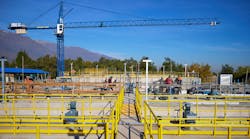Each day, an average of 700 water mains burst, while leaking pipes waste an estimated 7 billion gal of water, according to the American Society of Civil Engineers.
Approximately 30% of pipes in systems delivering water to 100,000-plus people are between 40 and 80 years old, and about 10% are even older, according to the U.S. Environmental Protection Agency.
Public water systems face various challenges to maintain infrastructure and deliver safe drinking water to customers. They must balance resources, financial demands, water availability, population and climate changes, regulatory requirements and operational costs. Physical water loss, however, leads to inefficiency and direct revenue loss.
A system struggling with high water loss faces numerous problems. It requires suppliers to extract, treat and transport greater volumes of water; all of these processes lead to greater energy use. Additionally, leaks and main bursts eventually find their way into the waste and storm water collection systems, resulting in additional treatment expenses. Last but not least, water loss puts a strain on available water sources. All of these factors have made it nearly impossible for water loss to be ignored.
Most water systems experience some form of water loss. While it cannot be completely avoided, it can be managed in order to remain in economic limits. That is why leak detection is a necessary component to the management of water distribution systems. Accurately pinpointing the position of leaky water pipes within a supply system and performing the appropriate repair or replacement helps systems not only conserve water and energy but prevent significant revenue loss.
There are various methods for detecting water distribution system leaks. Anything from sonic leak detection equipment, which identifies the sound of water escaping a pipe, to the implementation of advanced metering systems, can result in operational efficiencies and distribution reliability.
Advances in metering technology have allowed utilities access to real-time monitoring of water loss that might otherwise go undetected for years. While implementation of these leak detection and metering solutions does not come cheap, on average, the savings of water no longer lost to leakage outweigh the cost of leak detection services and repair.
Whatever the means of water loss prevention, one thing is certain: Drip, drip, drip is a sound utilities can no longer tolerate.
Be sure to review this month’s Problem Solver (page 40), which highlights how the city of Colby, Kan., reduced more than 100 million gal of water lost with a $1.78-million project that detected leaks and created an automated meter reading system to accurately read new water and electric meters throughout a 3.3-sq-mile service area.
Download: Here


